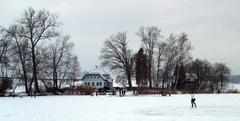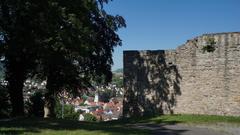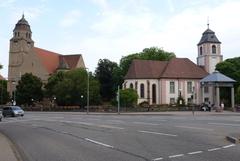Visiting Barbarakapelle in Pforzheim: Hours, Tickets, and More
Date: 17/08/2024
Introduction
The Barbarakapelle, or St. Barbara Chapel, stands as a testament to Pforzheim’s rich historical and cultural heritage. This chapel, named after St. Barbara of Nicomedia, holds a special place in the hearts of locals and visitors alike. Constructed around 1330 by monks from the Herrenalb Monastery, the Barbarakapelle quickly became a significant pilgrimage site, especially in the mid-15th century when an image of St. Barbara was believed to possess miraculous powers (second.wiki). The chapel’s architectural splendor, characterized by its Gothic style, adds an extra layer of allure to this historical gem. The octagonal floor plan, Gothic pointed arch portal, and magnificent rose window are just a few of the features that make this structure an exemplary model of medieval craftsmanship (komoot). Despite facing periods of decline, particularly during the Reformation, the chapel has been meticulously restored, preserving its historical and cultural significance for future generations. Whether you’re an architecture enthusiast, a history buff, or simply someone looking to explore the rich tapestry of Pforzheim’s past, the Barbarakapelle offers a unique and enriching experience.
Table of Contents
- Introduction
- Historical Background
- Architectural Significance
- Cultural and Religious Importance
- Restoration and Preservation
- Legends and Myths
- Visitor Experience
- Events and Activities
- Visitor Information
- Nearby Attractions
- FAQ
- Conclusion
Historical Background
The Barbarakapelle dates back to the medieval period, with its origins around 1330 when it was constructed by monks from the Herrenalb Monastery. It became a prominent pilgrimage site in the mid-15th century due to an image of St. Barbara believed to have miraculous powers (second.wiki).
Architectural Significance
An exemplary model of Gothic architecture, the Barbarakapelle features a two-storey structure with an octagonal floor plan. Notable elements include the elegant Gothic pointed arch portal, a magnificent rose window, and a star vault inside (komoot). These features highlight the craftsmanship of the period and contribute to the chapel’s architectural allure.
Cultural and Religious Importance
During the Reformation in 1556, the chapel’s significance as a pilgrimage site declined, leading to its disrepair. However, it was rebuilt in the 17th century, reviving its religious importance. Today, it remains a site for occasional outdoor services, maintaining its cultural relevance (second.wiki).
Restoration and Preservation
The Barbarakapelle has undergone several restorations to preserve its integrity. In 1899, the dilapidated chapel was demolished and a new one was constructed, consecrated on October 14, 1900. Restoration efforts included installing a Barbara statue and a wrought-iron grille from the time of construction (rlp-tourismus).
Legends and Myths
Surrounded by numerous legends and myths, the Barbarakapelle’s mystique is enhanced by stories such as an underground passage stretching to Ettlingen. These legends make the chapel a fascinating destination for folklore enthusiasts (second.wiki).
Visitor Experience
Visitors can enjoy a rich historical and cultural experience at the Barbarakapelle. Located on a hill with scenic views, it is accessible via well-marked trails, making it a popular destination for hikers and history enthusiasts. The serene environment is perfect for reflection and appreciation of its historical significance.
Events and Activities
The chapel hosts various events throughout the year. A notable tradition is the Holy Mass held in the nearby St. Valentinus Church, followed by a light procession to the chapel where Barbara branches are blessed and distributed (outdooractive).
Visitor Information
Visiting Hours
The chapel is open to visitors year-round, but it is best to visit during daylight hours. Check local resources for any seasonal changes.
Tickets
Entry to the chapel is free. Donations are welcome to aid in its preservation.
Accessibility
The site requires a short hike, so comfortable walking shoes are recommended.
Best Time to Visit
Spring and summer months offer pleasant weather and blooming landscapes.
Nearby Attractions
In addition to the Barbarakapelle, visitors can explore other historical sites in Pforzheim such as the Kappelhof Museum, which houses Roman artifacts, and the Schlosskirche St. Michael, the entombment site for the Margraves of Baden (werelate, wikipedia).
FAQ
Q: Is there an entry fee for Barbarakapelle?
A: No, entry is free, but donations are welcome.
Q: Are there guided tours available?
A: Check with local tourism offices for guided tour availability.
Q: Can I visit the chapel year-round?
A: Yes, but it is best to visit during daylight hours.
Conclusion
Visiting the Barbarakapelle in Pforzheim is not just about exploring a historical monument; it’s about immersing oneself in the rich cultural and architectural heritage that this chapel embodies. From its medieval origins and Gothic architectural marvels to its cultural significance and the legends that surround it, the Barbarakapelle offers a comprehensive glimpse into Pforzheim’s storied past. The chapel’s restoration efforts and its ongoing role as a site for religious and cultural events underscore its enduring relevance. As you plan your visit, consider the best times to explore, the nearby attractions, and the various activities that make this site a must-visit. Whether you’re drawn by the history, the architecture, or the serene environment, the Barbarakapelle promises a memorable and enriching experience. Don’t forget to check out other historical sites in Pforzheim, and immerse yourself in the city’s rich cultural tapestry (werelate).





